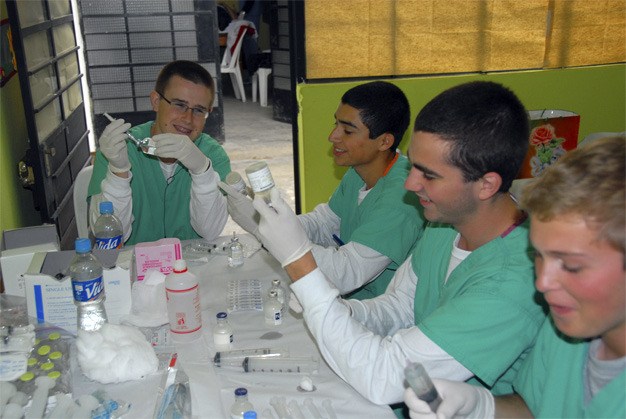Dr. Cheryl Hayes specializes in physical medicine and rehabilitation, the medical specialty concerned with diagnosing, evaluating and treating patients with physical disabilities. It took two years to plan, but Hayes and her husband Leo Catallo, son Matt Catallo, and three other young men, Brian Sedlacek, Carlos Barrios and Sam Mildeberger, recently returned from a medical mission in Peru.
All four boys are seniors this year at Mercer Island High School. The group was outside of Lima, the capitol of Peru, where they set up exam rooms in part of a Catholic mission.
The gates opened up every morning and the patients lined up. They treated 1,150 patients in a little over four days.
Hayes said she and 29 other physicians from all over the world were doing orthopedic procedures using a technique called prolotherapy. Prolotherapy is also known as non-surgical ligament reconstruction and is a treatment for chronic pain.
Prolotherapy uses a 5 percent dextrose (sugar-water) solution, which is injected into the ligament or tendon where it attaches to the bone. The solution also includes sodium chloride and a numbing agent, lidocaine.
The injection causes a localized inflammation in these weak areas, which then increases the blood supply and flow of nutrients and stimulates the tissue to repair itself.
Hayes said it’s not a mainstream procedure, and her first purpose was to introduce prolotherapy to the Peruvian doctors and other physicians on the mission.
“You need to have a good understanding of anatomy and be fearless of needles,” Hayes said. “This operates more on a principle of natural healing.”
Historical review shows that a version of this technique was first used by Hippocrates on soldiers with dislocated, torn shoulder joints. He would stick a hot poker into the joint, and it would then miraculously heal. Doctors don’t use hot pokers today, but the principle is similar — get the body to repair itself.
Leo Catallo works for SonoSite in Bothell, a company that makes hand-carried and mountable ultrasound equipment. He brought ultrasound equipment with him to use for directing the injections and to image parts of the body. He also documented the trip with photos.
The four boys were mixing the solutions and filling the syringes, the size of which could terrify the squeamish, since the injections are delivered close to the bone.
“The whole idea with prolotherapy is to go deep, to the bone almost,” Hayes said.
Matt Catallo and Sedlacek filled the prolotherapy syringes while Barrios and Mildeberger filled the anesthetic syringes.
“We stocked rooms, made sure everything was clean,” Matt Catallo said.
Sedlacek said the needles didn’t bother him at all; in fact, none of the boys “freaked out,” Hayes said. She said all four did a tremendous job.
Many of the patients were impoverished, but not all were. Sedlacek said he remembers a 7-year-old girl who had a hard time walking. Hayes examined her, had her stand on her tiptoes and found nothing wrong. Then they saw her shoes, which were several sizes too big. The girl’s mother said she really liked those shoes. Hayes told the mother to put them away for two or three years.
Barrios said a blind man — who fell from a two-story building and messed up his back quite badly — had an effect on him.
“He came in and saw us and was pain-free after that,” Barrios said. Barrios, who speaks fluent Spanish, also served as a translator when needed. A partially deaf woman named Sophia, with back problems, was able to touch her toes after prolotherapy and was all smiles.
“That was the most rewarding for me,” Barrios said.
Hayes said Peruvians are tough people. Where they were, most of the work is in construction or other industrial occupations. She said the people are small in stature, but stocky and strong.
All four boys are turning this experience into their culminating projects for their senior year. Barrios, Mildeberger and Sedlacek are all thinking of a career in medicine, while Matt Catallo wants to become an attorney. The family knows the Peruvian consulate, so the group did get to observe the Peruvian Congress and meet some of the Congressmen while they were there.
Catallo will be comparing the Peruvian government to the U.S. government for his senior project. Sedlacek plans to focus his project on the work they did at the clinic and prolotherapy. Barrios intends to write about how he was able to apply his Spanish skills to something truly useful, and Mildeberger is planning to focus on the culture shock he experienced, working in the clinic and comparing how different his life is from the lives he witnessed.



